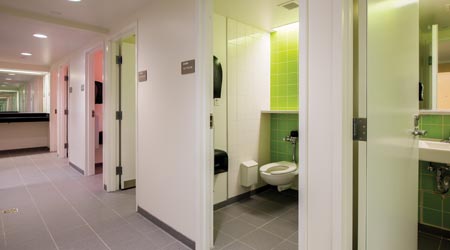 At the University of Pennsylvania, a newly renovated residence hall incorporates gender-neutral, single-occupant restrooms. Elsewhere at the school, changing existing single-user restrooms to gender-neutral facilities was mainly a matter of signage.Aislinn Weidele for Mills + Schnoering Architects
At the University of Pennsylvania, a newly renovated residence hall incorporates gender-neutral, single-occupant restrooms. Elsewhere at the school, changing existing single-user restrooms to gender-neutral facilities was mainly a matter of signage.Aislinn Weidele for Mills + Schnoering ArchitectsUniversities Lead In Gender-Neutral Restroom Design
Virginia Tech and the University of Pennsylvania both have had success designing gender-neutral restrooms in buildings such as a student union and newly renovated residence hall.
Over the past few years, the staff at the Virginia Tech Union received more requests from event organizers for gender-neutral facilities, says Eric Margiotta, associate director of student engagement and campus life. Until recently, the university would offer a single-user restroom located in the administrative suite.
The administration decided to address the requests on a more permanent basis. “We want to make sure everyone has access to a restroom where they feel welcome and safe,” Margiotta says. The university also wanted to ensure it was meeting the needs of students with disabilities.
In the fall of 2017, the Virginia Tech administration began designing and constructing a single-occupant, gender-neutral restroom within the public area of the union. To accomplish this, it’s repurposing a storage room that has easy access to plumbing, which helps keep costs down.
Margiotta recommends including the larger community in the design process. “You don’t want to build in a vacuum,” he says. He and his colleagues invited members of the disability and LBGTQ communities to voice their thoughts. For instance, one initial idea was to add a shower and bench to the restroom. However, input from these communities indicated a greater preference for using the space available to create additional restrooms.
The University of Pennsylvania has focused on accommodating preferences for single-occupant, gender-neutral restrooms since 2011, says David Hollenberg, university architect. The interest came both from campus leadership and the school’s LBGTQ communities.
A first step toward gender-neutral restrooms was to develop a spreadsheet of all single-occupant restrooms across campus. Hollenberg and his team considered most buildings other than residence halls. They ruled out any not truly available to the public, such as those in deans’ offices. For safety concerns, the teams also ruled out ones in remote locations or that weren’t highly public.
Between 100 and 125 locations remained. Hollenberg and his staff compared each against a checklist from the LBGT Center. They confirmed that each was single-user, publicly accessible, and lockable from the inside. They also checked that each contained a panic alarm, and had signage that could easily be replaced. This narrowed the list to about 80 restrooms; with new construction, the number has since grown to about 115 restrooms.
Converting the existing restrooms to gender-neutral ones was primarily a matter of changing the signage. Hollenberg and his colleagues replaced existing signs with ones that simply denote “restroom;” those that are large enough to meet ADA requirements include a pictogram of an individual in a wheelchair.
In addition, a newly renovated residence hall at the University of Pennsylvania incorporates gender-neutral, single-occupant restrooms. A series of stalls, each of which is partitioned from floor to ceiling, includes a shower and toilet, as well as an occupancy indicator. The stalls open to common sinks.
The residence hall featuring this design opened in fall of 2017, so it’s too early to assess the reception and longer-term impact. However, “the whole renovation has been popular,” Hollenberg says. He adds that several schools within the university have expressed interest in learning more about gender-neutral restrooms.
Related Topics:














